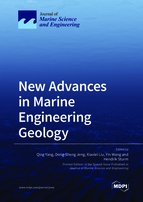New Advances in Marine Engineering Geology
A special issue of Journal of Marine Science and Engineering (ISSN 2077-1312). This special issue belongs to the section "Ocean Engineering".
Deadline for manuscript submissions: closed (30 April 2020) | Viewed by 48967
Special Issue Editors
Interests: unsaturated soils; marine soil mechanics; offshore geotechnical engineering
Interests: offshore geotechnics; ocean engineering; coastal groundwater hydraulics; offshore wind energy
Special Issues, Collections and Topics in MDPI journals
Interests: marine engineering geology; wave-seabed interactions; submarine sediment gravity flows; seafloor in-situ test and observation
Special Issues, Collections and Topics in MDPI journals
Interests: macroscopic and microscopic properties of marine soils; foundations of offshore platforms; discrete element method
Special Issue Information
Dear Colleagues,
The ocean is the cradle of life and is rich in natural resources. With the worldwide boom in exploration and application of ocean resources, a dramatically increasing amount of coastal engineering and offshore engineering facilities have been constructed in the last few decades. The rapid development of human economic activities and the global climate change are having a significant impact on the marine environment, resulting in frequent geological disasters. Under this circumstance, there is an urgent demand for a platform for scientists and engineers to share their state-of-art research outcomes in the field of Marine Engineering Geology.
The 2nd International Symposium of Marine Engineering Geology (ISMEG 2019) will be held in Dalian, China, on 18–20 October 2019. The theme of this symposium is “Exploration of Marine Resources and Marine Engineering Geology”. It will provide a great opportunity for scientists and engineers worldwide to discuss recent advances, share their knowledge, and identify future research directions in the field of Marine Engineering Geology. Seven topics will be discussed in the symposium: 1) Engineering Properties of Marine Soils; 2) Marine Geological Hazards and Preventions; 3) In situ Exploration, Monitoring, and Physical Modelling; 4) Hydrodynamics and Environmental Interaction; 5) Exploration of Gas Hydrate; 6) Offshore Foundations; 7) Pipe–Soil–Fluid Interaction.
ISMEG 2019 will invite top researchers worldwide to submit papers, share their research outcomes, and report recent advancements on the key topics mentioned previously. It is expected to receive more than 50 contributions from high-profile senior academic researchers and young researchers, on the basis of previous experience.
The objective of this Special Issue is to publish high-quality papers from ISMEG 2019 participants. The submitted papers will go through JMSE peer-review process, like regular papers. It is believed that this Special Issue will provide a timely overview of marine engineering geology and geotechnics of recent cases, theoretical advances, laboratory and field testing, design methods, and the potential for further development of these disciplines. Moreover, with a timely and well-organized publication, the state-of-the-art data, analyses, and methodologies presented in this Special Issue could be of great interest to all the readers of Journal of Marine Science and Engineering.
Prof. Dr. Qing Yang
Prof. Dr. Dong-Sheng Jeng
Prof. Dr. Xiaolei Liu
Assoc. Prof. Dr. Yin Wang
Dr. Hendrik Sturm
Guest Editors
Manuscript Submission Information
Manuscripts should be submitted online at www.mdpi.com by registering and logging in to this website. Once you are registered, click here to go to the submission form. Manuscripts can be submitted until the deadline. All submissions that pass pre-check are peer-reviewed. Accepted papers will be published continuously in the journal (as soon as accepted) and will be listed together on the special issue website. Research articles, review articles as well as short communications are invited. For planned papers, a title and short abstract (about 100 words) can be sent to the Editorial Office for announcement on this website.
Submitted manuscripts should not have been published previously, nor be under consideration for publication elsewhere (except conference proceedings papers). All manuscripts are thoroughly refereed through a single-blind peer-review process. A guide for authors and other relevant information for submission of manuscripts is available on the Instructions for Authors page. Journal of Marine Science and Engineering is an international peer-reviewed open access monthly journal published by MDPI.
Please visit the Instructions for Authors page before submitting a manuscript. The Article Processing Charge (APC) for publication in this open access journal is 2600 CHF (Swiss Francs). Submitted papers should be well formatted and use good English. Authors may use MDPI's English editing service prior to publication or during author revisions.
Keywords
- Engineering Properties of Marine Soils
- Marine Geological Hazards and Preventions
- In-situ Exploration, Monitoring, and Physical Modelling
- Hydrodynamics and Environmental Interaction
- Exploration of Gas Hydrate
- Offshore Foundations
- Pipe–Soil–Fluid Interaction










